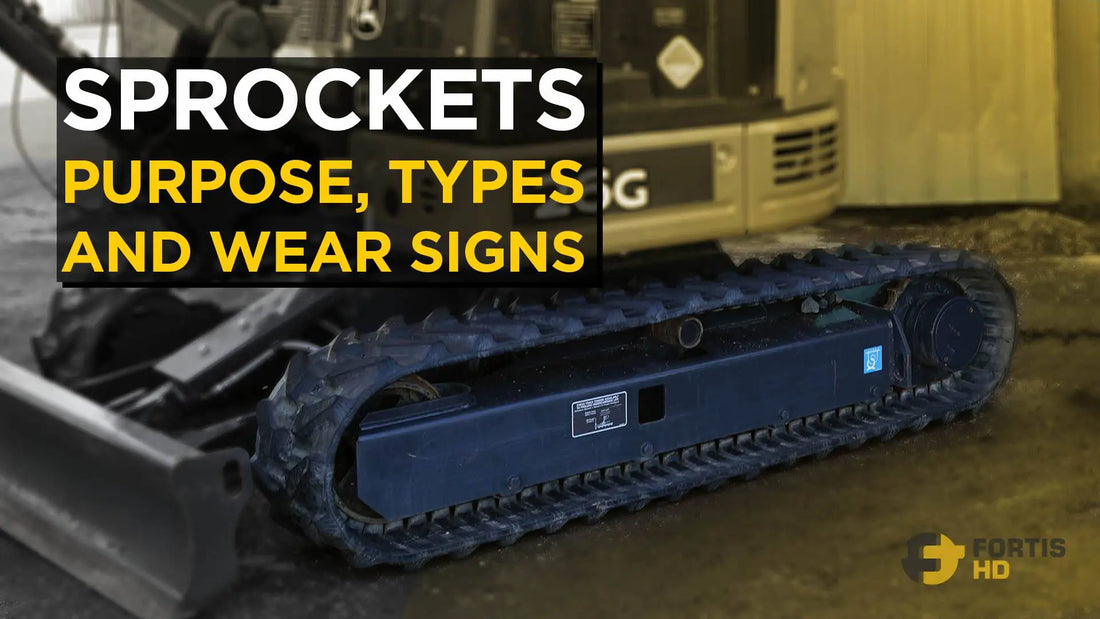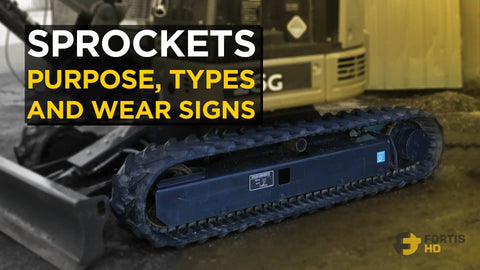
A Thorough Explanation of Heavy Equipment Sprockets: Purpose, Types, and Wear Signs
Written by Luis Montes
Updated On August 26, 2024

Featured Tools
+

Written by Luis Montes
Updated On August 26, 2024

+
The sprocket, a part of the final drive system, is a wheel with teeth that mesh and engage with the rubber track steel links to impulse (forward or reverse) track heavy equipment.
We’ll discuss the main topics regarding your rubber-tracked machine sprocket, from design variations to maintenance, to help you get the most out of this component and your heavy equipment.

The sprocket is bolted to the final drive and transmits the torque the reduction gear systems generate to the rubber track. The sprocket teeth engage the rubber track steel inserts, pushing the rubber track, which interacts with the ground by friction, grip, or both, trying to push the ground.
Under favorable conditions and because of Newton’s third law, the ground reacts with an equal, opposite force, pushing the undercarriage.

As the undercarriage moves (thanks to the rollers), the sprocket pulls the track and sends it toward the front idler.
In the following video, Keith, an expert heavy equipment mechanic, replaces the track adjuster on a Komatsu PC200 excavator. While he assembles the track back together, you can see what we meant by the sprocket pulling and sending the track toward the front idler.
However, the above is only possible with high-quality rubber tracks that generate friction with hard soil and deep cleats that grip into soft ground. Otherwise, tracks will just slip and turn endlessly.

Visit Fortis HD to buy OEM-approved aftermarket sprockets and premium rubber tracks to maximize the performance of your compact track loader, multi-terrain loader, or mini excavator.
The number and size of teeth and the overall design of the sprocket can vary depending on the equipment’s type, size, and brand.

The sprocket is on the same level as the front idler in oval-tracked undercarriages.
In triangular-shaped undercarriages, the sprocket is above the front and rear idlers.
According to Caterpillar, who holds the patent for the high-drive track-type vehicle design, the reasons for an elevated sprocket are:

Photo sources: www.jewellmachinery.com / www.govplanet.com / www.cleveland-equipment.com
The elevated sprocket design is standard for compact track loaders and large-size equipment, which frequently must operate in challenging terrain. However, some manufacturers still use the conventional track design for their skid steers, especially for mini versions.
Certain machines, such as excavators, rely on conventional track designs to move and be able to spin their cabs.

The position of the sprocket affects the size of its teeth because of the wrap angle, which is the amount of track wrapped around the sprocket. With a higher wrap angle, more teeth engage with the track, and vice versa.
The above is why teeth on compact track loader sprockets are beefier than those on mini excavators.

An elevated sprocket has a smaller wrap angle than those on conventional undercarriage, meaning fewer sprocket teeth engage with the rubber track steel inserts.

Conventional compact track loaders have a friction-type sprocket. It engages the rubber track steel links, and on the way out, the relative motion between the steel inserts and the sprocket tooth causes friction. Thus, their distinctive curve wear pattern.
Brands like ASV, Terex, and Caterpillar feature posi-drive sprocket technology, greatly reducing friction between the sprocket and track.
The posi-drive system replaces the sprocket teeth for pins and bushings, much like steel track undercarriages. Instead of steel links, the bushings engage with drive lugs inside the rubber track, which are part of the rubber compound—ASV rubber tracks don’t have a steel core (steel links and cables).
Although posi-drive sprockets minimize friction, their design requires the manufacturing and assembly of several parts, which vary with the size of the machine (also increasing their purchase price), as you can see in the following diagrams for the ASV RC30, RC85, and SR80 CTL models:



In addition, posi-drive sprockets are not too practical regarding downtime reduction due to repair and maintenance.

As mentioned, a sprocket wears due to contact, load, and relative motion between its teeth and the rubber track steel inserts or between the rollers and drive lugs in the case of posi-drive machines.
Although wear on sprocket teeth varies, it’s easy to spot by a visual inspection or a simple measurement.

Depending on the operator’s driving and maintenance habits, teeth can wear in one of the following ways


If the wear on your sprocket isn’t quite perceivable with a visual inspection or if you are more of a calculation person, some Cat equipment manuals include a method for telling whether you must relocate or change your sprocket.
For this method, as the illustration above shows, you must have previously measured the distance between the outer opposite faces of two non-consecutive teeth on a new sprocket.
The method is as follows:
Here’s an example to make it clearer.
The distance between the opposite outer faces of two non-consecutive teeth for a new sprocket on the Cat 279C, 289C, and 299C is 178 mm—this isn’t the same as two times the pitch, which is equal to 172 mm.

If the average of 3 measurements is 170 mm, relocate the sprocket.

If the average of 3 measurements is 160 mm (less than 7.3% = 165 mm), replace the sprocket.

Manufacturers recommend changing the outer rollers of posi-drive sprockets when they are more than 50% worn of their original thickness.
On average, a new roller is about 1/4″ thick. When they get to 1/8″ or less, replace it.
Since the bolts holding the rollers are constantly stressed, they also recommend replacing them with the rollers.

First, clean your undercarriage daily to maximize its life.
Operating the machine in muddy or sandy conditions will accelerate the wear on the sprocket and other undercarriage components.
Sand, pebbles, and small debris act like sandpaper, increasing wear due to friction between the sprocket and track.
Snow and mud buildup between the sprocket teeth causes the rubber track steel links to ride higher, causing premature tip wear. Eventually, the steel links will slip or skip over the sprocket teeth, increasing friction and wear on both the track and sprocket.
Next, check your rubber track tension. An excessively loose track will slap at high ground speeds, resulting in high-impact loads on the sprocket teeth.
Lastly, after relocating or replacing your sprockets, using an impact with a torque wrench is a good practice to ensure you comply with the bolt torque specs your machine’s manufacturer recommends.

Experience the difference in quality and reliability with Fortis HD’s heavy equipment tools. Shop today for tools that keep you ahead in the industry.
Your heavy equipment sprocket transfers the power from the final drive to your tracks.
The contact, heavy pressure, and relative motion against the rubber track steel links wear off the sprocket teeth fairly quickly. Although posi-track sprockets greatly reduce friction, they are also susceptible to wear. Keep an eye on the thickness of their outer rollers.
Daily cleanliness will extend the lifespan of your sprocket (and other undercarriage components), especially when working in sandy or muddy conditions.
Sprockets are one piece of the undercarriage mechanical puzzle, so we prepared articles on track rollers and wheel idlers to give you a wider picture of tracked machines. Make sure to check them out:

Fortis HD offers precision-engineered, OEM-approved aftermarket mini excavator sprockets designed to surpass your expectations.
Check our sprockets section for the most popular brands: Bobcat, John Deere, Cat, Kubota, Takeuchi, and more.